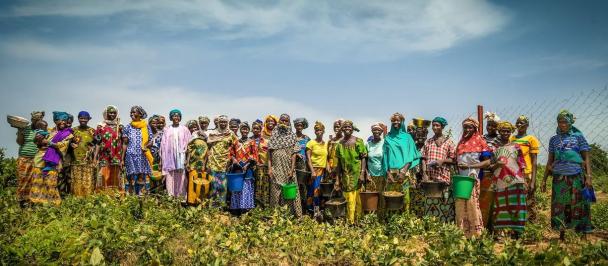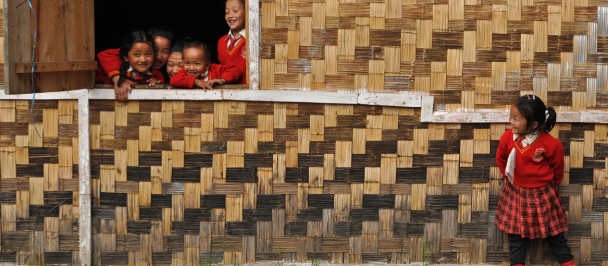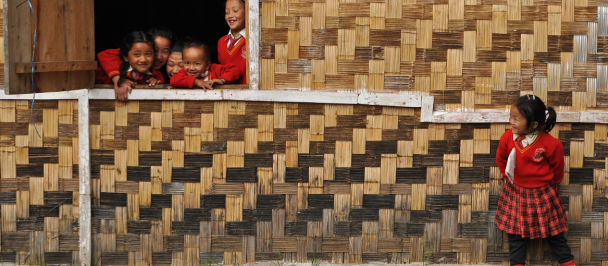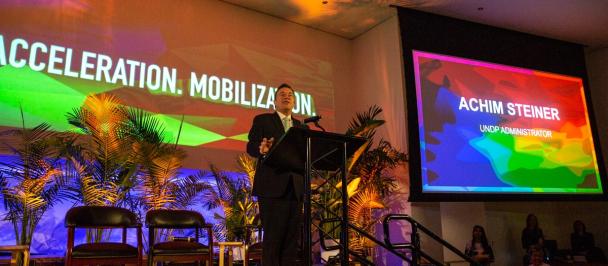Closing remarks at HLPF Side Event: Reducing inequalities by promoting a just and inclusive transition with ambitious climate action
Reducing inequalities
July 17, 2019
As prepared for delivery
Opening
I would like to thank all of the speakers for their valuable insights on how to reduce inequality through climate action.
What has struck me is that inequality is one of the greatest paradoxes of our times; in recent decades innovation has exploded, poverty has gone down in every region of the world and emerging markets are booming. Yet inequalities persist and grow, intersecting and reinforcing each other and perpetuating intergenerational poverty and exclusion.
Inequality represents a huge obstacle to any kind of sustainable future. It not only hampers countries and people from reaching their full potential -- it tag-teams with climate change to push the most vulnerable even further down, robbing them of their own ability to take climate action.
The poorest are hardest hit by almost every climate setback, but especially land degradation, harvest losses, air pollution and lack of water.
The UN Secretary-General’s new report on the Sustainable Development Goals (SDGs) shows that the pace of poverty reduction is now stalling, and inequality is rampant. It does however demonstrate that we are making progress. Extreme income poverty has been reduced from 36 per cent in 1990 to about eight per cent today. It means that billion people have been lifted out of extreme income poverty. This shows that development is working.
However, people want more than to just survive on US $1.90 a day. The SDGs call for the elimination of poverty in all of its forms.
The United Nations Development Programme (UNDP) has just launched the 2019 Global Multidimensional Poverty Index (MPI) with the Oxford Poverty and Human Development Initiative (OPHI). The MPI complements income poverty measures with dimensions that cannot be transacted in markets. UNDP is making the case for studying overlapping deprivations which multiply exponentially and deprive people, especially women, of the chance to achieve their potential. The MPI -- now covering 101 countries and 76 per cent of the global population -- shows that 1.3 billion people in the world are multidimensionally poor: about 500 million more than the number of income poor. One of the surprising findings of the report is that the burden of world multidimensional poverty falls upon children. In world that produces a new billionaire every two days, the poverty rate for children is twice as high as for adults.
However, UNDP’s MPI shows that there has been significant success progress in reducing multidimensional poverty. 270 million people were lifted out of multidimensional poverty from one survey to the next. Those furthest behind are moving up the fastest. Once again this shows that, development is working.
Inequality and Climate Change
There is no doubt that climate change will further exacerbate existing poverty and inequality. Developing countries will bear an estimated 75 to 80 per cent of the costs of climate change. The World Bank estimates that climate change could push 120 million more people into poverty by the year 2030.
One recent study found that climate change has already worsened global inequality and that the gap in per capita income between the richest and poorest countries is 25 percentage points larger than it would be without climate change. Thus, the discussions at the G7 Environment Forum in May on how to fight inequality though the lens of climate action and protection of biodiversity were especially pertinent.
We also know that climate hazards and stressors are increasingly leading to protracted displacement, more complex disasters and prolonged conflicts. Consider one of Africa’s driest regions, the Sahel, which is particularly vulnerable to climate change. Projected increasing temperatures are higher than the rest of the continent resulting in irregular rainfall which impacts upon agricultural yields and increases socio-economic hardship. As the Executive-Secretary of the UN Convention to Combat Desertification (UNCCD) pointed out at the G7 meeting on fragility -- deterioration of the environment is often seen in fragile states. 83 per cent of people in the Sahel are dependent on agriculture but 85 per of the land is degraded and non-arable. There are conflicts between herders because natural resources become scarcer whole age-old mediation structures have broken down. Such developments are compounded by the impacts of rapid demographic growth, poverty, gender inequality, political instability and conflict. Although the Sahel faces a range of interlinked challenges, there is hope that we must support as the international community -- for instance the potential for renewable energy such as solar power.
In the past number of years, we are seeing that conflict is blocking the arteries of progress. Look at the fact that the steepest decline in UNDP’s Human Development Index (HDI) ranking last year was in countries suffering protracted conflict: the Syrian Arab Republic fell 27 places, followed by Libya, which fell 26 places, and Yemen, which fell 20 places. Fragility and conflict are also tightly interlinked with poverty and inequality. Indeed, UNDP research has highlighted how inequality between communities is a key driver of conflict. Conflict preys upon countries that are already facing poverty -- where institutions are fragile and resources, few. Indeed, more and more conflicts will be driven by this race for natural resources – and climate change, the greatest variable of the 21st Century – will exacerbate this situation.
“Pathways for Peace”, a World Bank-UN report has found that by 2030, more than 60 per cent of the world’s poor will live in countries affected by fragility and high levels of violence unless global action is taken. Therefore, this situation no longer be resolved in “business as usual” mode. I believe that we must recognise that development “failures” are one the root causes of conflicts. The international community needs to address the root causes of fragility and instability as most effective way to prevent crisis and ensure sustained peace. That means more investment in countries at an early stage. That includes support to governance institutions so that they can provide, in an equitable and inclusive way, service delivery, rule of law, human rights, justice and reconciliation. That also includes supporting the ability of countries to tackle climate change to strengthen their resilience to future shocks and crises. We also need to work more closely together, in an integrated manner to address such fragility properly -- and not as separate development, peace and humanitarian actors.
It is also clear that the issues of climate, fragility and development are closely interlinked – and we have a framework to address these interwoven challenges in the SDGs and the Paris Agreement. Not only do these two frameworks reference and reinforce each other, but there is also a high degree of coherence between them: 154 out of the 169 SDG targets are directly aligned with specific Nationally Determined Contributions (NDCs) adopted by countries.
On climate action, UNDP works in over 140 countries to meet the climate challenge head on and support solutions from the ground up. UNDP, together with other UN Agencies and partners focus on three strategic and transformative pathways for “bending the curve” on greenhouse gas emissions: increasing the scope of ambition and accelerating the implementation of NDCs, accelerating climate action by mobilizing institutions and resources, and aligning policies and plans with climate-smart resilient approaches. That includes increasing resilience to storms in Small Island Developing States, to promoting green businesses in Latin America to the “Bright Africa Partnership” which is designed to provide solar energy to one million people and create 500,000 jobs in the Liptako-Gourma region (Mali, Burkino Faso and Niger).
Delivering on the 2030 Agenda, the SDGs and the Paris Agreement -- and breaking the chronic underinvestment in prevention, will not only help bring prosperity -- but will represent our best defence against future shocks and crises.
Closing
I note that many of France’s G7 priorities resonate strongly with UNDP’s work -- for instance, tapping into the opportunities created by digital technology and artificial intelligence in an ethical and human-oriented way. UNDP is also transforming itself to pivot towards a new era of development. One of our new initiatives is in the UNDP Accelerator Labs. Together with our core partners, the Federal Republic of Germany and the State of Qatar -- 60 labs will serve 78 countries. We will work together with international, national and local partners to find grassroots solutions that work and then help to scale them up. Many of these new initiatives will relate to climate action while also creating new opportunities which help to reduce inequality at the same time.
The fact that France is putting inequality, the environment and climate action at the forefront of its international diplomacy is very gratifying to see. France is taking a lead role in number of fora on these vital issues including its work on the climate finance track of the vital Climate Action Summit hosted by the UN Secretary-General in September; in the G7 and G20; and through its organization of “One Planet Summits” which mobilizes both public and private actors -- amongst a range of other areas.
It is also a time when we need strong leadership – and even stronger action.
It is very clear that inequality is holding us all back. It threatens our world order, our political systems, human rights, peace and security, and the sustainable future that we seek for ourselves and for our children. The 2030 Agenda recognizes that we cannot combat the huge challenges we face as a planet - such as poverty and climate change -- if we do not squarely confront it.
UNDP will continue to play a robust part in advancing this much-needed progress.

 Locations
Locations




